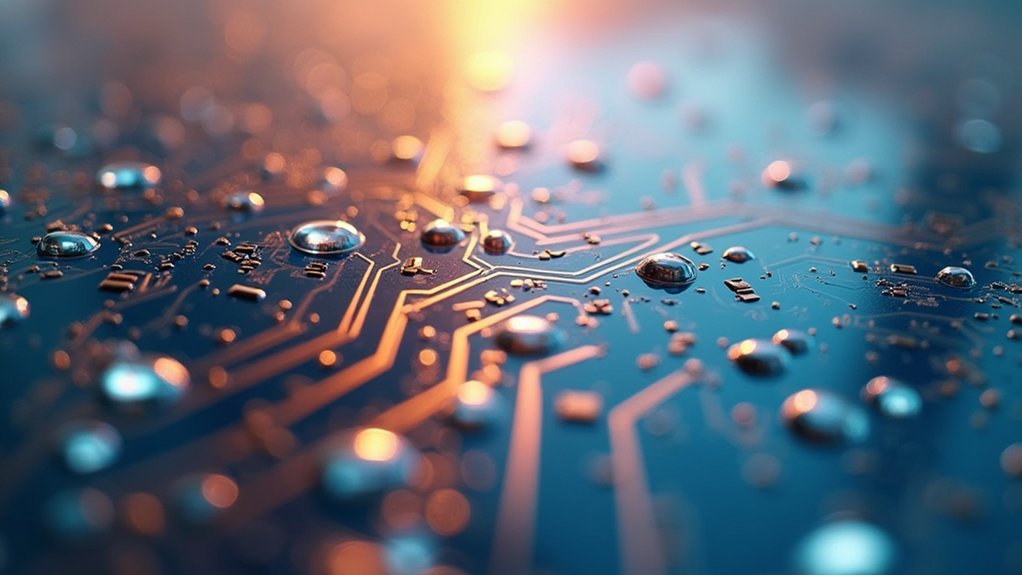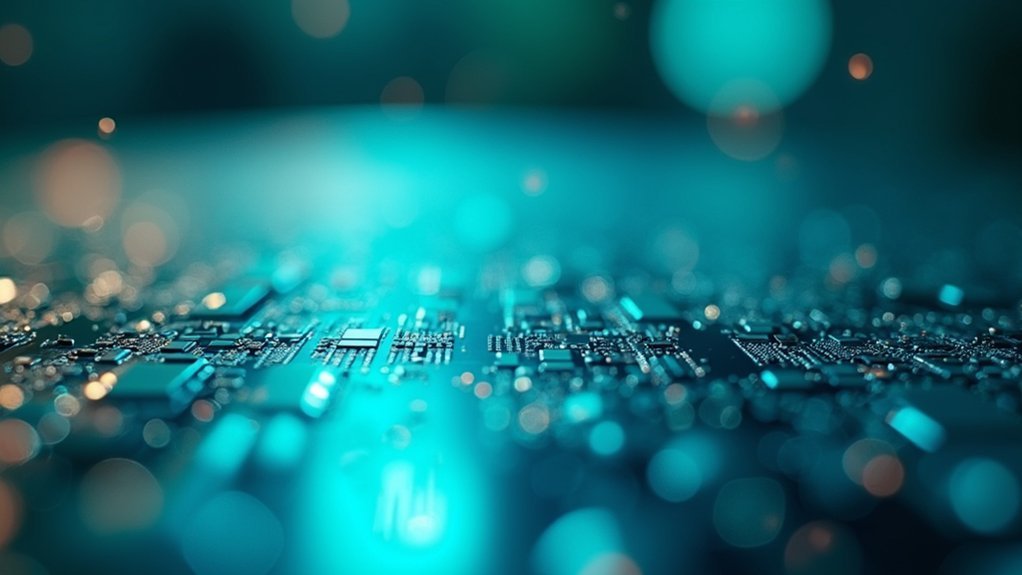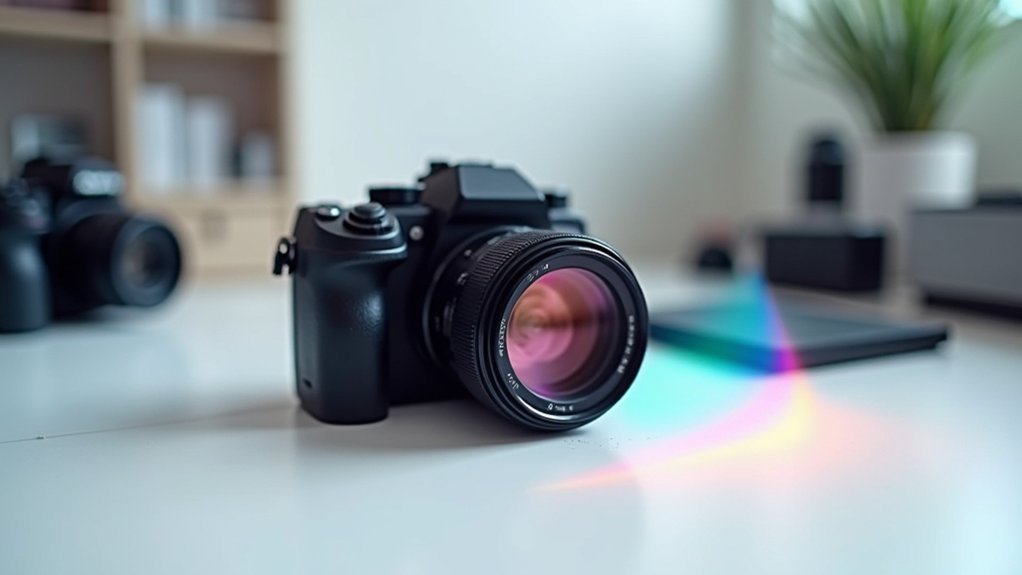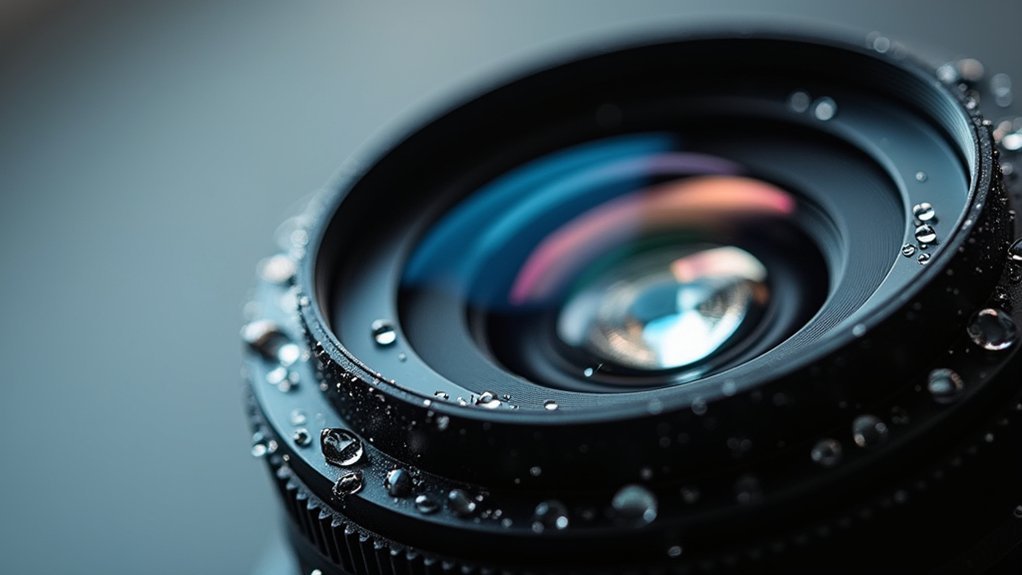To clean electron microscope images, start by optimizing pre-acquisition settings with lower beam currents and proper calibration. Apply Gaussian filters and wavelet-based techniques during post-processing to reduce noise while preserving critical details. For hardware solutions, invest in proper electromagnetic shielding and vibration-dampening systems. You’ll get better results by selectively targeting specific noise patterns rather than applying general reduction. The perfect balance between noise reduction and detail preservation awaits in the techniques below.
Clean Electron Images: Pro Noise Reduction Tips

While capturing perfect electron images remains challenging, you’ll find that proper noise reduction techniques can dramatically improve your results.
High-quality noise reduction software like Topaz DeNoise AI is essential for preserving critical details while eliminating unwanted noise.
Start with lower Luminance values in your workflow, then adjust based on your image’s ISO. This approach prevents over-smoothing while still achieving better results.
For precision, use Lightroom’s Adjustment Brush to apply noise reduction selectively to areas that need it most, keeping important details crisp.
Consider exploring wavelet-based techniques for advanced control—they allow you to target smaller scales where noise is more prevalent.
Regular practice with different tools and settings will refine your ability to balance noise reduction and detail preservation effectively.
Understanding Noise Sources in Electron Microscopy
Before applying any noise reduction techniques, you’ll need to identify what’s actually causing the noise in your electron microscopy images. Various sources contribute to image degradation, including electronic noise from detectors, thermal noise from samples, and shot noise from electron emission statistics.
High voltage fluctuations in your electron beam can considerably impact image quality. When your signal-to-noise ratio is poor, fine structural details become obscured, potentially leading to misinterpretation of your results.
Sample preparation plays an essential role in noise management—consider using conductive coatings to minimize charging effects.
Once you’ve addressed physical sources, implement specialized noise reduction algorithms designed specifically for EM data. These computational approaches can enhance clarity while preserving vital details in your images that might otherwise be lost.
Pre-Acquisition Strategies to Minimize Signal Interference

Since electron imaging quality depends heavily on initial setup conditions, implementing robust pre-acquisition strategies can dramatically reduce noise before it enters your system.
Start by calibrating your camera sensor properly to minimize thermal noise and hot pixels during prolonged exposures.
Proper sensor calibration eliminates thermal noise before it contaminates your electron imaging data.
Conduct your imaging in controlled environments with stable lighting to prevent fluctuations that introduce unwanted artifacts. You’ll achieve better results by selecting lower ISO settings whenever possible, as this notably improves your signal-to-noise ratio without post-processing.
Consider exposure stacking as one of your essential noise reduction tools—averaging multiple images effectively eliminates random noise patterns.
Don’t overlook physical accessories; a simple lens hood or diffuser prevents flare and reflections that degrade image clarity.
These pre-acquisition approaches will yield cleaner electron images that require minimal correction afterward.
Beam Energy Optimization for Cleaner Base Images
Selecting the ideal beam energy represents one of the most critical factors in producing high-quality electron microscopy images with minimal noise.
You’ll find that higher beam energies typically enhance your signal-to-noise ratio, directly contributing to superior image clarity. However, you must balance this benefit against potential beam-induced damage to your sample.
For effective noise reduction, consider using lower beam currents while extending exposure times, especially when working with sensitive specimens.
Don’t overlook the importance of precise beam alignment and focusing techniques—these guarantee your electron beam hits exactly where intended, greatly reducing background noise.
Make beam energy optimization part of your regular workflow by calibrating your microscope and adjusting parameters based on specific sample characteristics.
This systematic approach will consistently deliver cleaner, more detailed electron images.
Detector Calibration Techniques for Noise Prevention

While optimizing beam energy creates a solid foundation for low-noise imaging, your detector’s calibration status will ultimately determine image quality. Proper detector calibration greatly minimizes systematic errors and sensitivity variations across your sensor.
Implement dark frame subtraction to combat thermal noise—capture an image without light exposure and subtract it from your actual images. This technique effectively eliminates hot pixels that compromise clarity.
For consistent results, incorporate flat field calibration to correct pixel-to-pixel variations and enhance image uniformity.
Don’t overlook environmental controls. Temperature stabilization during imaging reduces thermal fluctuations that generate noise.
While some may rely on noise reduction in Lightroom during post-processing, preventing noise at the source through regular calibration with reference standards guarantees consistently cleaner electron images across all your sessions.
Multi-Frame Averaging Methods for Enhanced Clarity
When random noise threatens image quality, multi-frame averaging emerges as one of the most powerful techniques in electron microscopy. By capturing multiple images with identical exposure settings and combining them, you’ll dramatically reduce random noise while preserving critical details in your specimens.
- Transform your low light imaging – Watch as previously obscured structures emerge from noisy backgrounds with each additional frame.
- Achieve publication-quality results – Your colleagues will notice the difference when your images feature signal-to-noise ratios impossible with single captures.
- Simplify your workflow – Let software like PixInsight handle alignment and averaging automatically.
- Customize your approach – Experiment with different frame counts to find your perfect balance between noise reduction and detail preservation.
For ideal results, guarantee consistent alignment between frames during the averaging process.
Spatial Filtering Approaches for Post-Processing

You’ll find that Gaussian filters provide excellent noise reduction in electron images by applying a weighted averaging algorithm that preserves critical structural details.
Fourier transform techniques complement spatial filtering by working in the frequency domain, allowing you to target specific noise patterns that commonly plague electron microscopy data.
Neighborhood averaging methods offer a simpler but effective approach when you need quick results, as they replace each pixel value with the average of surrounding pixels to smooth out random fluctuations while maintaining overall image integrity.
Gaussian Filters Implementation
Among the most powerful tools for noise reduction in electron microscopy, Gaussian filters stand out for their effectiveness and mathematical elegance. You’ll find them indispensable when processing noisy electron images, as they efficiently smooth out random variations while preserving vital structural details.
The key lies in selecting an appropriate standard deviation – too large and you’ll lose valuable image quality, too small and noise persists.
- Balance is essential – aim for the sweet spot where noise disappears but edges remain crisp
- Start conservative – you can always increase blurring, but can’t recover lost details
- Preview results – compare filtered regions against your original to evaluate effectiveness
- Consider multi-pass filtering – sometimes gentler repeated applications yield better results than one aggressive pass
Fourier Transform Techniques
Moving beyond simple spatial smoothing, Fourier Transform techniques offer a more sophisticated approach to noise reduction in electron microscopy. By converting your images from spatial to frequency domain, you can selectively target and remove noise components while preserving critical structural details.
When applying this method, you’ll find that specific frequency components associated with unwanted noise can be filtered out using spatial filtering approaches like low-pass filters. For ideal image quality, try implementing a Gaussian filter in the Fourier domain—this creates a smooth shift between preserved signal and eliminated noise.
You’ll need to carefully tune your filter parameters to achieve the right balance. When properly implemented, these Fourier Transform methods greatly reduce noise artifacts while maintaining the integrity of your electron microscopy images’ underlying features.
Neighborhood Averaging Methods
While Fourier techniques operate in the frequency domain, neighborhood averaging methods tackle noise directly in the spatial domain where your electron images are natively represented.
These powerful spatial filtering approaches can greatly reduce noise while preserving critical structural information.
When applying neighborhood averaging methods to your electron images, consider these options:
- Gaussian blurring – Weights nearby pixels using a Gaussian function for smooth, natural-looking noise reduction
- Median filtering – Excellently preserves edges while eliminating outlier pixels, ideal for high-contrast electron images
- Box filtering – Offers quick processing but use cautiously as excessive application can erase detail in your image
- Neighborhood size selection – Smaller neighborhoods preserve detail while larger ones reduce more noise—balance based on your specific sample characteristics
Wavelet-Based Denoising for Detail Preservation

When traditional noise reduction falls short, wavelet-based denoising emerges as a powerful solution for electron images requiring fine detail preservation. This technique selectively targets smaller wavelet layers containing noise while preserving larger layers with critical image details. You’ll achieve better signal-to-noise ratios without sacrificing image integrity.
| Scale Level | Noise Content | Processing Approach |
|---|---|---|
| Fine | Highest | Strong reduction |
| Medium-fine | High | Moderate reduction |
| Medium | Moderate | Light reduction |
| Coarse | Low | Minimal reduction |
| Very coarse | Negligible | Preservation only |
For high-ISO electron images with fine textures, you can apply masks to control which areas receive noise reduction. Modern software like Photoshop now offers wavelet-based denoising capabilities comparable to specialized tools, giving you professional results while maintaining your subject’s natural appearance.
Machine Learning Applications in Noise Identification
As electron microscopy continues to evolve, machine learning has revolutionized noise identification and reduction techniques. By analyzing pixel patterns, these advanced algorithms can differentiate between luminance and color noise, allowing you to process images more efficiently than traditional methods.
- Instant optimization – Deep learning models automatically adjust noise reduction settings based on image characteristics, saving you countless hours of frustrating trial-and-error work.
- Superior detail retention – CNNs intelligently preserve critical image details while removing unwanted noise patterns.
- Workflow acceleration – Machine learning reduces post-processing time by up to 70%, letting you focus on analysis rather than cleanup.
- Adaptive performance – These systems continuously improve as they process more electron images, delivering increasingly precise noise identification with each use.
Contrast Enhancement Without Amplifying Artifacts
When enhancing electron images, you’ll find selective frequency masking particularly effective at isolating specific detail bands while suppressing noise patterns.
This technique lets you target precise frequency ranges where important structural details exist, allowing for contrast enhancement without amplifying the unwanted artifacts that typically reside in different frequency bands.
Subheading Discussion Points
Achieving ideal contrast in electron images requires a delicate balance between enhancement and noise management.
When you’re applying contrast, focus on selective noise reduction techniques that target problematic areas while preserving critical details. Using Lightroom’s masking tools gives you precise control for better noise reduction in specific regions.
- Transform your workflow by switching to LAB color mode, adjusting only the Lightness channel for cleaner contrast enhancement.
- Revolutionize your results by using layer masks to isolate high-detail areas from noise-prone sections.
- Master your histograms to prevent highlight or shadow clipping that can worsen noise artifacts.
- Elevate your images with clarity and vibrance adjustments instead of aggressive sharpening for natural-looking contrast.
Selective Frequency Masking
Selective frequency masking represents one of the most effective approaches for enhancing electron image contrast while minimizing noise amplification. This technique separates your image into distinct frequency layers, allowing you to target noise reduction precisely where needed.
When working with electron microscopy images, you’ll find that applying noise reduction primarily to low-frequency components preserves critical high-frequency details like cellular boundaries and structural features. By manipulating these separate layers, you’re effectively cleaning up the image without sacrificing sharpness.
For ideal results, use layer masks in your editing software to control the intensity of noise reduction across different image regions. This approach proves particularly valuable when processing electron images captured under challenging conditions, where you need to balance detail preservation with noise elimination.
Your images will maintain scientific accuracy while becoming visually cleaner.
Advanced Edge Preservation During Noise Reduction
While reducing noise in electron images, preserving edge integrity remains one of the most vital challenges you’ll face. Effective noise reduction shouldn’t sacrifice the sharp shifts that define your subject’s features.
Wavelet-based techniques offer a selective approach, applying stronger processing to smaller layers while protecting edge details in larger ones.
- Control with precision – Use masking techniques to shield essential edges from excessive smoothing, maintaining the scientific accuracy your work demands.
- Layer your approach – Apply noise reduction in separate Photoshop layers to fine-tune edge preservation without compromising detail.
- Leverage AI solutions – Tools like Topaz DeNoise AI offer specialized settings that balance noise reduction with edge definition.
- Adjust selectively – Remember that detail preservation isn’t uniform—different regions of your electron images may require customized noise reduction settings.
Hardware Solutions for Electron Image Noise Control
You’ll achieve cleaner electron images through optimized camera housing designs that incorporate proper thermal isolation and minimal internal reflections.
Electromagnetic shielding applications, including Faraday cages and specialized coatings, protect your imaging system from external field interference that would otherwise degrade image quality.
Vibration dampening systems featuring pneumatic isolation tables and active compensation technology eliminate motion-induced blur that commonly affects high-magnification electron microscopy.
Optimized Camera Housing Design
The foundation of effective electron image noise reduction begins with proper camera housing design.
Your camera housing serves as the first line of defense against various noise sources that can compromise image quality. By focusing on improved camera housing design, you’ll greatly enhance your electron imaging results.
- Insulate with low thermal conductivity materials – These materials prevent heat transfer that causes thermal noise, keeping your sensor cool and images crisp.
- Install effective electromagnetic shielding – Block interference from nearby devices that would otherwise create unwanted artifacts in your images.
- Incorporate vibration-dampening mounts – Eliminate mechanical vibrations that blur fine details during critical imaging moments.
- Integrate advanced cooling systems – Active thermal management maintains ideal sensor temperature, ensuring consistent performance even during extended imaging sessions.
Electromagnetic Shielding Applications
Building upon our camera housing fundamentals, we now focus on specific electromagnetic shielding applications that provide hardware-based noise reduction in electron imaging systems.
You’ll achieve the best results by selecting appropriate shielding materials based on your specific interference sources. Copper offers superior protection across a wide frequency spectrum, while aluminum provides lightweight alternatives for less demanding applications.
The effectiveness of your shield depends on its shielding effectiveness (SE) value—aim for higher dB ratings for critical imaging work.
Don’t overlook proper grounding techniques when implementing shielding solutions. Even the finest copper enclosure fails without correct grounding, as noise coupling can bypass your physical barriers.
Design your shielding to target the specific frequency ranges affecting your electron imaging system for maximum noise reduction and cleaner images.
Vibration Dampening Systems
While electromagnetic interference can considerably degrade electron image quality, mechanical vibrations represent an equally formidable challenge that requires specialized hardware solutions.
Your electron microscopy results depend on effective vibration dampening systems that can reduce noise levels by up to 90% when properly implemented.
- Pneumatic isolation tables use air pressure to absorb unwanted mechanical vibrations, giving you dramatically clearer images.
- Custom-designed spring systems matched to your lab’s specific vibration frequency profile deliver ideal noise reduction.
- Regular calibration guarantees your dampening equipment maintains peak performance over time.
- Properly maintained rubber mounts provide cost-effective vibration isolation for less sensitive applications.
Remember to select dampening systems specifically designed for the frequency range of vibrations in your laboratory environment for the best achievable results.
Frequently Asked Questions
What Is the Best Way to Denoise an Image?
You’ll get the best denoising results using dedicated AI software like Topaz DeNoise AI. Adjust Lightroom’s Luminance slider for basic noise reduction, then use selective editing with the Adjustment Brush for targeted improvements.
How to Reduce Noise in Image Processing?
To reduce noise in image processing, you’ll want to use AI tools like Topaz DeNoise, adjust Lightroom’s Luminance and Color sliders, apply selective reduction techniques, stack multiple exposures, or try specialized plugins like Noiseware.
Should I Turn on Noise Reduction on My Camera?
You should try your camera’s noise reduction for high ISO and low-light shots, but be aware it might slightly reduce detail. Test both with it on and off to find your preference for different situations.
How to Fix Grainy Night Photos?
To fix grainy night photos, use a tripod for longer exposures at lower ISO settings. You’ll get cleaner results by shooting in RAW and applying noise reduction software like Lightroom or Topaz DeNoise AI afterward.
In Summary
You’ve now mastered professional noise reduction for electron microscopy. By addressing noise at its source, optimizing beam parameters, and applying advanced computational techniques, you’ll produce cleaner images without sacrificing detail. Remember, it’s the combination of pre-acquisition preparation and post-processing finesse that’ll elevate your work. With these tools in your arsenal, you’re ready to capture stunningly clear electron images every time.





Leave a Reply